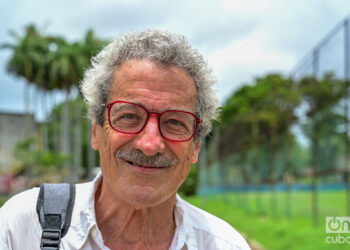Photos: Alain L. Gutiérrez and courtesy of the author
A resounding and, for some critics, “mega” exhibition is now open until February in the gallery El reino de este mundo, at the emblematic Jose Martí National Library in Havana, featuring the most recent pictorial production of Mario García Portela. He is a solid Cuban artist who has focused for more than half a century on landscapes.
Portela, who is without question and by his own right a master of contemporary Cuban art, was born in the western province of Pinar del Río in 1942. Now he surprises us with renewed, rejuvenated and vital force in Tierra oscura (Dark land), an intense, unique exhibition, not just because of its portrait-like depictions of landscapes, but also because of the way Portela has fragmented every painting.
The exhibition features a total of nine acrylic paintings on canvas; five diptychs (10 pieces), three triptychs (9 pieces) and one polyptych. If we think about it in mathematical terms, Tierra Oscura occupies an area of approximately 50 square meters of cloth.
In more than half a century of working in the “painter’s trade,” this is the first time that Portela has turned to using such large formats—some pieces are more than four meters, something that the describes as “unique,” because it has forced him to “loosen up and not be so meticulous and such a perfectionist,” characteristics for which he is known.
By using a large format, he has “obtained interesting results that may be even better than my previous work,” he said in an exclusive interview with OnCuba. He also affirms categorically that Tierra oscura “is not an exhibition that represents a rupture,” but that it is “the largest step forward” that he has taken in his landscape paintings in the last 20 years.
His palette has always been very small, and continues to be. He does not use primary or secondary colors; instead, he uses earth tones, siennas, ochres and, subtly, white. “I’ve never been a colorist,” he notes, revealing that he set aside oil paintings as soon as he discovered acrylics, about 20 years ago.
He is a graduate of the prestigious Academia de Artes (Academy of Arts) in Pinar del Río, and a student of Tiburcio Lorenzo, Luis Fuentes Quesada, Carlos Hernández Alcocer, Fausto Ramos, Raúl Eguren and others. When he was just 11 years old, Portela began making paintings of the Valle de Viñales, a valley in Pinar del Río province that is one of the island’s most beautiful geographic features. “I have a photo in which I appear next to an oil painting—of 90 by 60 centimeters—that I had just painted, showing Viñales,” he says proudly.
In the 1960s, Portela began to work more with the female figure, and in the 1970s, he created a series devoted to calling attention to the war that was being waged by the Vietnamese people. In parallel, he made another series about heroes, “imbued with the epic atmosphere that was all around us at that time.”
In the early 1980s, encouraged by the Advisory Council for the Development of Monumental Sculptures (CODEMA), he returned to landscapes, and in 1992, he held an important, vast exhibition featuring that theme. No human beings appear in that work, because “in landscapes, the mark made by man seems more important to me than man in and of himself.”
Then came Pequeños ciudadanos del tiempo (Small citizens of time), in which he included clowns, an icon that became central to his work and gave him the opportunity for the first time to use the colors red, blue, green, yellow and orange, which he limits to small figures or objects that he introduces at times within the landscape with specific intentions. However, he admits that the series that “has been the strongest” is precisely Viñales, although in the ‘90s, he began working on Llegó Antonio (“Antonio is here), which depicts toys of different types.
He recounted how he was visiting his student and friend, Pedro Pablo Oliva, at home when “all of a sudden I heard a shout: ‘Antonio is here!’ It turned out that Antonio was someone who lived in the United States but who frequently went to Pinar del Río, and whenever he arrived, he would bring toys for the children and there would be a commotion in the whole neighborhood. Whenever you heard ‘Antonio is here!’ you would see the kids with baby strollers, skates, helmets, balls. I liked that, and I named my series after it, and in all sincerity, it has been very well-received.”
He has also done a series on Paisajes urbanos (Urban landscapes) and Retratos del bosque (Portraits of a forest), which focuses on the theme of mountains, using dark environments with a predominance of highlighted trees, giving the impression of “portraits.” That is the genesis or principle of Tierra oscura, an exhibition based on the suggestive idea of unity and fragmentation.
“Fragmentation within the family is something that I see and that I suffer on a personal level and on the level of the nation; it is a not just a Cuban phenomenon, but also an international one. Some family members have left the country permanently; others are working abroad or fulfilling an internationalist mission in other lands; or they simply move from the countryside to the city and vice versa. The family today is not what it was.”
It is true that the world is lacerated by divisions, something that Portela has conceptualized in Tierra oscura, an exhibition in which the paintings seem to be fragmented but form a single whole. And that is exactly the crux of the idea behind this work: “Despite fragmentation, there is unity.” And it is essential to hold on to that idea.



-60-x-50-cm-Impresión-lightjet-sobre-KODAK-Endura-papel-fotográfico_0-120x86.jpg)






